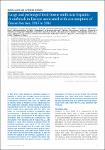Large and prolonged food-borne multistate hepatitis A outbreak in Europe associated with consumption of frozen berries, 2013 to 2014
Severi, Ettore
Verhoef, Linda
Thornton, L.
Guzman-Herrador, B. R.
Faber, Mirko
Sundqvist, L.
Rimhanen-Finne, R.
Roque-Afonso, A. M.
Ngui, S. L.
Allerberger, Franz
Baumann-Popczyk, A.
Muller, L.
Parmakova, K.
Alfonsi, V.
Tavoschi, L.
Vennema, H.
Fitzgerald, M.
Myrmel, M.
Gertler, Maximilian
Ederth, J.
Kontio, M.
Vanbockstael, C.
Mandal, S.
Sadkowska-Todys, M.
Tosti, M. E.
In May 2013, Italy declared a national outbreak of hepatitis A, which also affected several foreign tourists who had recently visited the country. Molecular investigations identified some cases as infected with an identical strain of hepatitis A virus subgenotype IA. After additional European Union/European Economic Area (EU/EEA) countries reported locally acquired and travel-related cases associated with the same outbreak, an international outbreak investigation team was convened, a European outbreak case definition was issued and harmonisation of the national epidemiological and microbiological investigations was encouraged. From January 2013 to August 2014, 1,589 hepatitis A cases were reported associated with the multistate outbreak; 1,102 (70%) of the cases were hospitalised for a median time of six days; two related deaths were reported. Epidemiological and microbiological investigations implicated mixed frozen berries as the vehicle of infection of the outbreak. In order to control the spread of the outbreak, suspected or contaminated food batches were recalled, the public was recommended to heat-treat berries, and post-exposure prophylaxis of contacts was performed. The outbreak highlighted how large food-borne hepatitis A outbreaks may affect the increasingly susceptible EU/EEA general population and how, with the growing international food trade, frozen berries are a potential high-risk food.
Dateien zu dieser Publikation
Keine Lizenzangabe
Verwandte Publikationen
Anzeige der Publikationen mit ähnlichem Titel, Autor, Urheber und Thema.
-
2022-01-14ZeitschriftenartikelEpidemiologie der Virushepatitiden A bis E in Deutschland Dudareva, Sandra; Faber, Mirko; Zimmermann, Ruth; Bock, C.-Thomas; Offergeld, Ruth; Steffen, Gyde; Enkelmann, JuliaMit Virushepatitis A bis E werden verschiedene infektiöse Entzündungen des Leberparenchyms bezeichnet, die durch die Hepatitisviren A bis E (HAV, HBV, HCV, HDV und HEV) ausgelöst werden. Zwar ähneln sich die Krankheitsbilder, ...
-
2022-01-14ZeitschriftenartikelEpidemiologie der Virushepatitiden A bis E in Deutschland Dudareva, Sandra; Faber, Mirko; Zimmermann, Ruth; Bock, Claus-Thomas; Offergeld, Ruth; Steffen, Gyde; Enkelmann, JuliaMit Virushepatitis A bis E werden verschiedene infektiöse Entzündungen des Leberparenchyms bezeichnet, die durch die Hepatitisviren A bis E (HAV, HBV, HCV, HDV und HEV) ausgelöst werden. Zwar ähneln sich die Krankheitsbilder, ...
-
2015-07-06ZeitschriftenartikelOccult Hepatitis B Virus Infection in Nigerian Blood Donors and Hepatitis B Virus Transmission Risks Oluyinka, Opaleye O.; Tong, Hoang Van; Tien, Sy Bui; Fagbami, Ademola H.; Adekanle, Olusegun; Ojurongbe, Olusola; Bock, Thomas; Kremsner, Peter G.; Velavan, Thirumalaisamy P.Background: Occult hepatitis B virus infection (OBI) characterized by the absence of detectable HBsAg remains a potential threat in blood safety. We investigated the actual prevalence, viral factors and genotype of OBI ...

